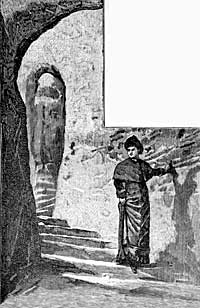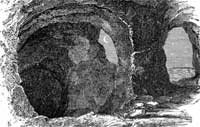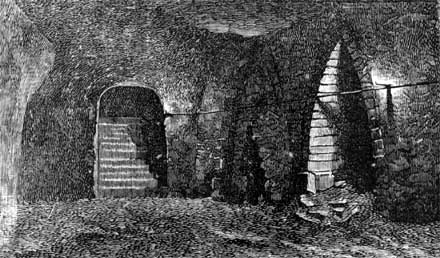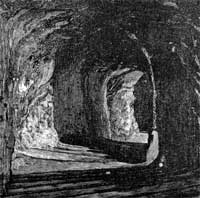
SUBTERRANEAN PASSAGE IN THE CASTLE ROCK.
The entrance to "Mortimer’s Hole" is effected from this terrace, by the wicket-gate, at a small charge—the history of which is recorded on a tablet underneath one of the window sills of the refreshment room. The outlet to the Norman Castle was the spot which is now railed round near one of the eastern windows of the Refreshment Rooms, to which reference has just been made.
The present approach to this subterranean passage, which runs through the rock down to the road level (a distance of slightly over a hundred yards), is by a flight of stone steps; the road then is through an archway, when the advantage of a light is recognised. The road is rugged for a little distance, when it is fairly good; and may readily be traversed by visitors of both sexes. At a little distance down there are several openings in the face of the rock, which enable visitors to get a glimpse of the town below and the country beyond. The east terrace should he traversed, and the descent to the grounds made by the terrace steps, and the gate approached by a circuitous footpath.
Nottingham Castle has had a threefold existence—as a Norman fortress, as a Royal Castle, and as a Renaissance Palace. The earliest positive record of a castle's existence appears to date back as far as William the Conqueror. The present building, which does not occupy above one-third of the space of the edifice which superseded it, was completed in 1683, and destroyed by a riotous mob, who set it on fire, on October 10th, 1831. The Norman Dungeons (an illustration of which is given) may be visited upon payment of a small fee. Application should be made at the catalogue tables to view these. The entrance to the Dungeons is by a doorway in the wall, near the lawn gate-posts. After passing down a few steps, and obliquely through a portion of the runs made in 1831, visitors will enter the Dungeons. These are lighted with gas, and ought to be visited by those who are interested in by-gone days. The plateau on the N.W. side of the Castle, was formerly used as a Drill Ground by the Robin Hood Rifle Volunteers, who have still their Head Quarters within the grounds,—near the monument erected to the memory of the officers and men of the (late) Nottinghamshire Regiment, who fell in battle.
 MORTIMER'S HOLE - VIEW NO. 1. |
 THE NORMAN DUNGEONS. |
 MORTIMER'S HOLE - VIEW NO. 2. |
